
I haven’t identified this cactus yet, but it was growing along I-10 in the Dome Rock Mountains. Click on image to enlarge.
28 March 2011. Quartzsite, Arizona isn’t my model of an ideal town. It’s a town of truck stops, fast-food restaurants, and—apparently—it hosts the largest gathering of RV’ers in the world. Each January, 750,000 to one million people converge on the town, mostly in RVs, for a week of massive flea markets and whatever else RV’ers do. The town is also well known in the rock & mineral crowd, do to the rich geology here. (I’m okay with that!) Just last week there was apparently some huge show; this is clearly the town’s angle, and I guess they do it well.
But all those people aren’t here right now—which is just fine with me! I arrived late afternoon, coasting down from the I-10 snaking corridor through the Dome Rock Mountains that lie between the Arizona border and here. After 84 miles yesterday, I took a more relaxed pace today, logging 49 miles (though my bicycle odometer/speedometer seems to crap out now and then—I’ll look down at it and see 0 mph, when I’m fairly certain that I’m going somewhat faster than that).
I started the day a little before sunrise. I had slept on the back porch, and Nancy had to leave at 6. I got to watch the sun rise over the mountains to the east. I ate some of Jerelyn’s granola and was on the road a little before 8 am.
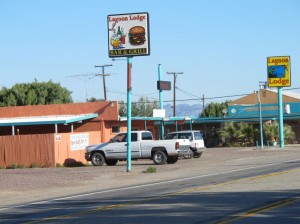
Sadly, the only really commercial establishment in Palo Verde is closing next week. The owner is going into a nursing home, and her son doesn’t want the business. Click on image to enlarge.
Nancy had suggested that instead of following 78 all the way to Blythe (about 25 miles away), I should detour east on less traveled roads. It was great advice; almost no traffic. I stopped often to check out the agricultural systems—particularly relative to water use. They use A LOT of water to grow cotton, wheat, alfalfa, and a few other crops.

These unlined canals must lose a tremendous amount of water through seepage. Click on image to enlarge.
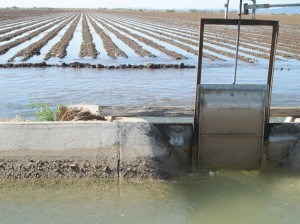
Here’s how it works. Water from the canal flows into the field through a sluice. Click on image to enlarge.
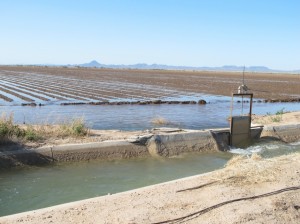
There were several points where water flowed into the cotton field—and it was a lot of water. Click on image to enlarge.
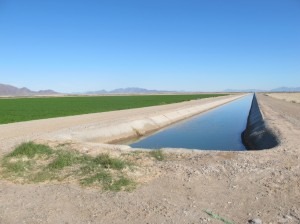
The alfalfa on the left is bright green; on the right was barren ground. Most likely the farmer had sold the water rights to LA. Click on image to enlarge.
At one point, I was photographing some emerging rows of cotton and a man stopped in his pick-up truck to ask if everything was all right. Really nice guy: Grant Chaffin, the general manager of Chaffin Farms and president of the Riverside County Farm Bureau. We chatted about Imperial Valley farming for about 20 minutes.
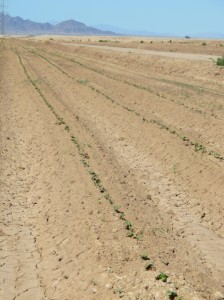
Emerged cotton seedlings. I was checking these out when the farmer stopped to see if I was all right. Click on image to enlarge.
Nearly all of the crops here are flood irrigated (which is the most water-intensive irrigation method—Grand didn’t tell me that). It’s all water diverted from the Colorado River just northeast of where we were (which I think was due east of Ripley). He farms 3,800 acres in those three crops. The cotton grown in the Imperial Valley is a shorter-staple Upland cotton, while the Pima cotton, grown further north in the Central Valley, is longer-staple and producing even better cloth. The wheat grown in the Imperial Valley is Durham wheat, a very high-grade wheat used in making pasta. Greg is fairly young and very enthusiastic to chat with an interested listener.
I didn’t follow all the detail, but it sounds as if the cotton seeds are planted fairly deep in these tall rows, flooded so that they germinate, then the tops of the hills are kind-of leveled off and tamped down (see photo). I don’t know how often the flooding is done throughout the growing season.

Every five minutes, it seemed, I saw something else that I had to stop and photograph, such as these red-wing and yellow-headed blackbirds in a lush alfalfa field. Click on image to enlarge.
Everything is either lush (irrigated) or totally dry and brown (not irrigated). Makes me think about the issue of the “embodied water” in our various products: cotton tee-shirts, hamburgers, even water bottles. Water may be the new energy.
I was surprised to see all the unlined canals for transporting water. The seepage must be huge—along with evaporation. I’ll have to look into that. Some of the land where I biked is newly fallow—abandoned as farmers have sold their water rights to Los Angeles.

With all the sterile, perfectly straight canals, I was pleased come come across this one, replete with ducks and other wildlife. Click on image to enlarge.
Anyway, with all the stops, it took me three hours of leisurely pedaling to make it the 25 miles to Blythe, where I planned to have lunch. I wasn’t in a rush, so found the Starbucks I had been told about with wireless and posted yesterday’s blog (though I couldn’t get the wireless to work so “tethered” from my iPhone). That took longer than I expected (mostly dealing with photos), then I stopped at a RiteAid to pick up a different kind of sunblock that may be more satisfactory and a flashlight. (Nancy said that you should always use a flashlight this time of year in the desert because of rattlesnakes; they’re recently out of hibernation and out looking for food. Convinced me!)
Heading out of Blythe it was a flat pedal to Ehrenberg at the California-Arizona border. The Colorado River separates the states, and you have to cross on I-10. Bikers are supposed to use the pedestrian walkway on the north side of the bridge. I had just ridden up the path to the walkway when two, heavily laden bicyclists approached, biking on the shoulder. They pulled up and we chatted for 15 minutes or so. Amazing story.
They are both Malaysian, but their English was pretty good. They were 21,000 kilometers (about 13,000 miles) into a round-the-world bike trip and near the end of the Miami-to-Los Angeles leg, which they had started 30 days ago (after flying over from London). From LA, they fly to Japan to finish their ride through Asia. We exchanged cards, and they invited me to bike in Malaysia any time. The card Abdul Khalib Bin Zakaria gave me says “Cycling Around the World in 288 Days,” so it must be a well-publicized trip—maybe trying to set some sort of record. I thought the guy I ran into two days ago in Ocotillo was impressive (cycling around the U.S. over a three-year period); these guys were amazing. I would guess that they had at least 75 pounds on each bike.
Great guys. Very friendly. Full of smiles. Unfortunately, the website isn’t in English, so I can’t learn the details.
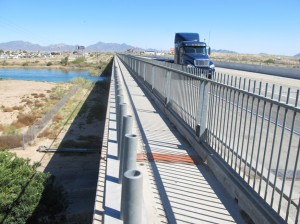
Crossing over the Colorado River into Arizona. The time was supposed to change, but it didn’t seem to. Click on image to enlarge.
After crossing the Colorado River, my route took me onto I-10, which then climbs up through the Dome Rock Mountains. I came across my first saguaro cactus as we rose in elevation, and saw one blooming cactus. It’s a little tricky to take photos of plants where there isn’t something sturdy to lean one’s bike against. I wheeled if off the shoulder a little ways and gently set it down on its side (watching out for cactus spines). I think the cactus photos were worth the effort.

Entering I-10 in Arizona. Interstates have wide shoulders with rumble strips to alert drifting vehicles, but they aren’t at all relaxing to pedal along. Click on image to enlarge.
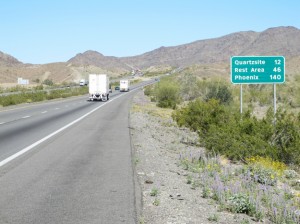
Climbing the Dome Rock Mountains. The 1,000-foot climb is gradual—not too bad. Click on image to enlarge.
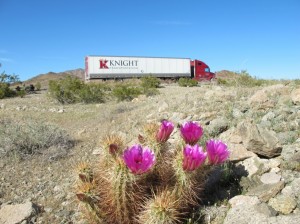
Another shot of these beautiful cactus blooms. I suspect that few drivers zooming along at 75 mph see these! Click on image to enlarge.
I got off I-10 at the Dome Rock Road exit for a much more relaxed pedal down into Quartzsite. No traffic. Lots of open space that’s available for camping. Until I learned about the RV convergence on Quartzsite, I couldn’t figure out why there were hundreds of fire circles throughout the land there; I guess in January it’s full of RVs. I could take I-10 right into Phoenix, but it wouldn’t be nearly relaxing; instead I’ll follow the Adventure Cycling route, which goes further north, through Wenden, Aguia, and Wickenburg en route to Phoenix.
So, back to Quartzsite. At least they have a sense of humor here. I’m staying at the Quartzsite Yacht Club Motel (where I also ate dinner). I still haven’t figured out the derivation of the name, perhaps they bet on yacht races. There are sailing flags from all over adorning the walls. My “motel room” is a mobile home. I’m in Room 112, which is the western half of a full-size (single-wide) mobile home. Kind-of a hoot, but the price was pretty good—half that of the Super 8 and mainstream chains. You don’t get a soap dish in the shower for that, but it’s way upscale from camping—and after a day of pedaling in the full sun, it’s nice to wash off the sunblock!
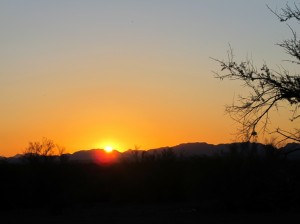
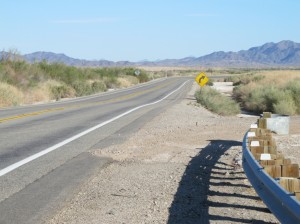
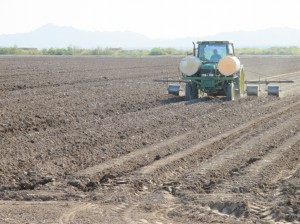


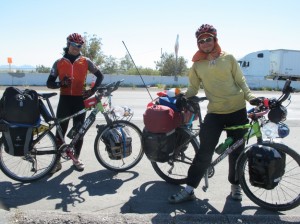
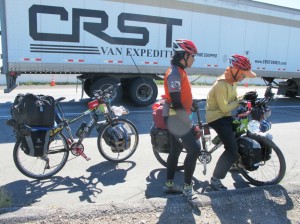
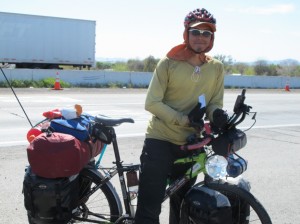
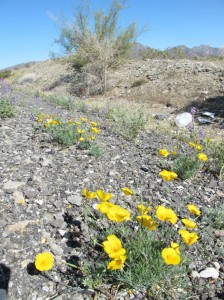

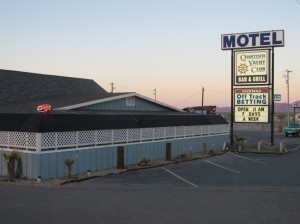
Seems like a quick stop into the next bike store (Phoenix?) for some dual kick-stands should be on the agenda. Surely that’s preferable to rattlesnakes and cactus spines! And probably a lot easier than resurrecting 50+ pounds of equipment after impromptu photo breaks.
Hey Alex! What a great adventure. Looking forward to reading more. And feeling inspired to plan my own bike tour. 🙂
Take care!
Great Job Alex — biking, bloging, and basking. I’ll stay tuned to read/see how your adventures continue to play out. Thanks for including us all. Not sure, but I think the prupleish flowered cactus is a hedgehog cactus (Echinocereus).
I can’t believe you’re already in Arizona! Must feel like a lot of work to you, but from here it seems like just yesterday you started out. The cotton photos really change the way I look at my sheets and t-shirts.
Keep that flashlight on to stay away from the rattlers—for our sake!
Alex, you have probably seen this, but interesting article in the NY Times about cotton competing with food crops for acreage, based on higher prices:
http://www.nytimes.com/2011/03/29/business/29cotton.html?_r=1
Alex, you’re making great time! You’ve gotten much farther in 6 days than I did at the beginning of my trip, that’s for sure. Try and work in some rest days, or at least some easier days, you don’t want to hurt yourself and have to stop biking. Also, careful where you lean your bike when you go into stores – sometimes there are appliances that mess with the magnet in your computer’s sensor. You might have biked a couple miles by the time you come back out, and your top speed will be 189 mph.
Love the posts, I feel like I’m right there with you. Have fun!